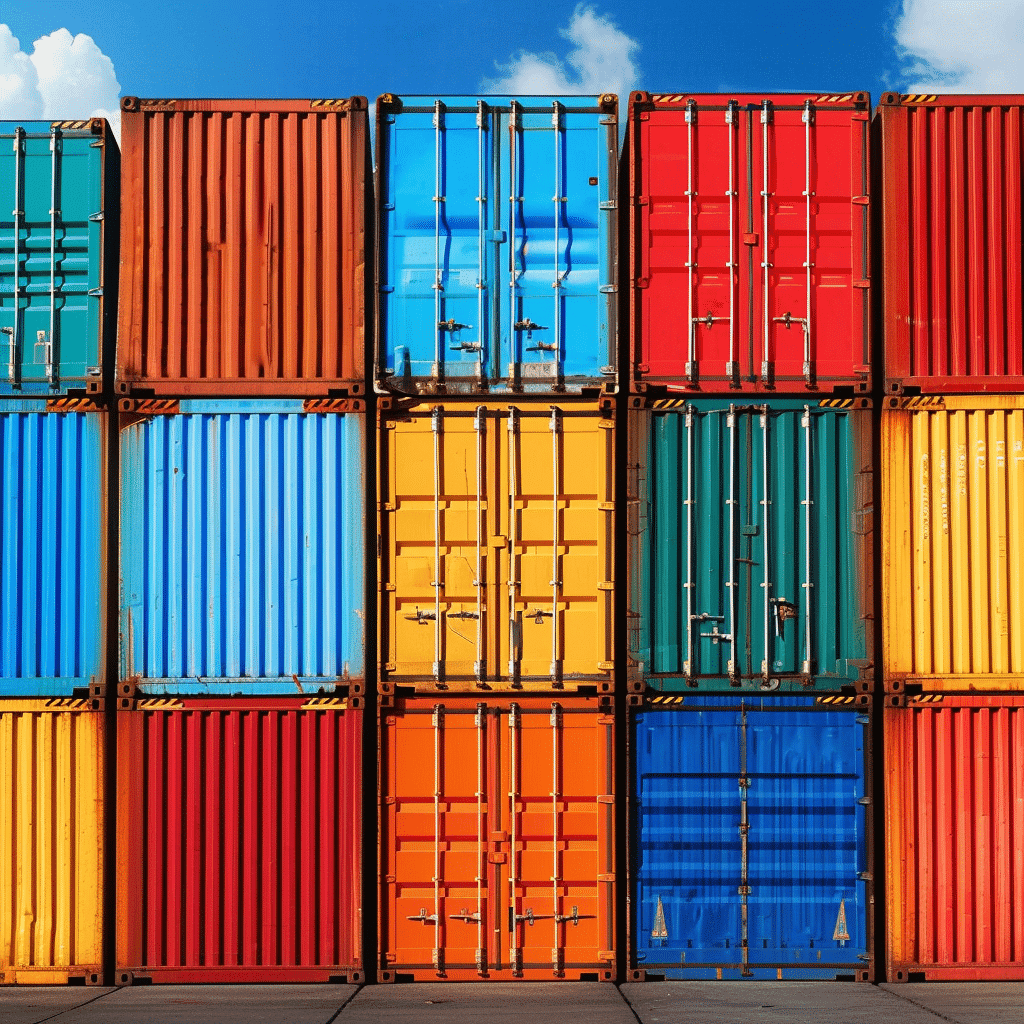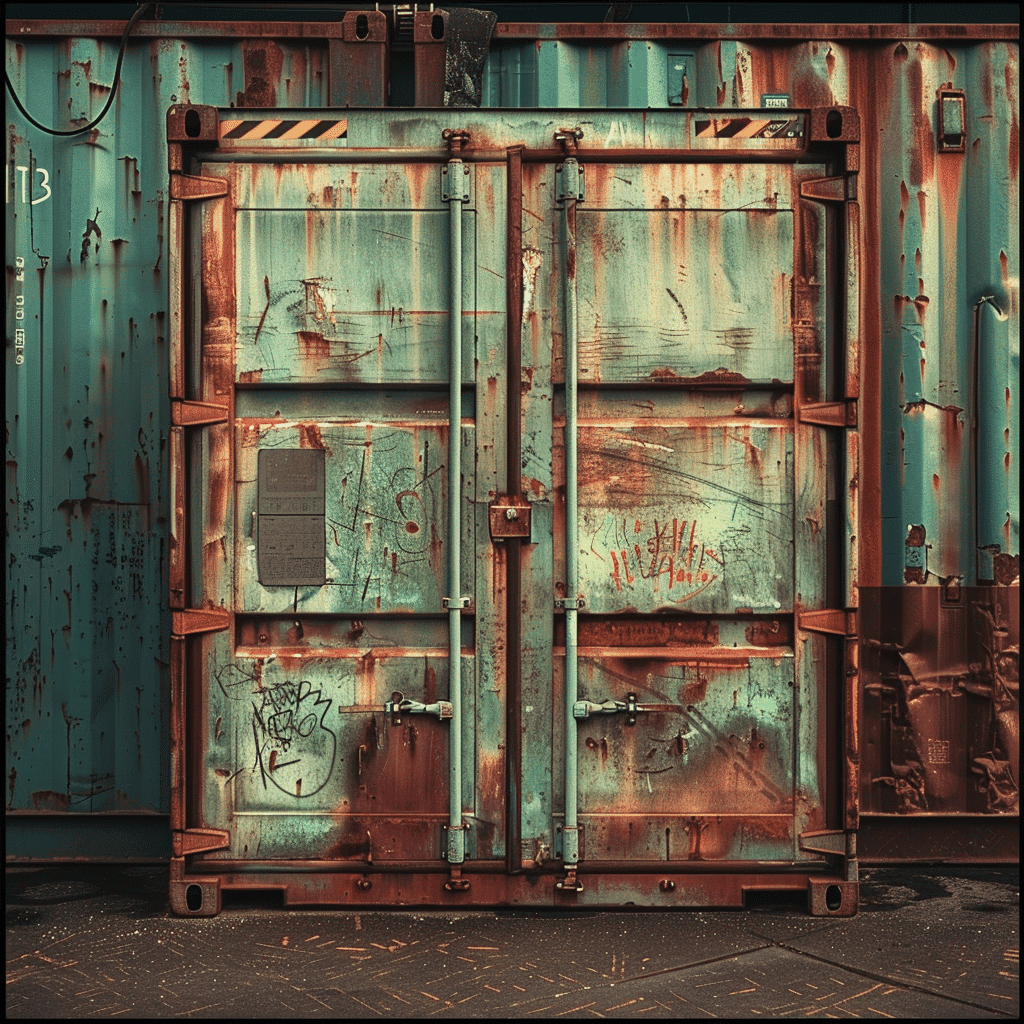Are you considering using shipping containers for storage? Before you start packing, it’s important to know what items should never be stored in them.
From hazardous materials to perishable goods, there are certain things that can cause damage or pose a danger.
In this article, we will guide you through the forbidden list of items and provide tips on maximizing the usage of shipping containers for a safe and efficient storage solution.
Understanding Shipping Container Usage
To understand shipping container usage, consider their versatility and various applications.
Shipping containers aren’t only used for transporting goods across long distances but also have gained popularity in the construction industry. One of the most notable applications is the use of shipping containers in building container homes. These homes are cost-effective and environmentally friendly alternatives to traditional housing. However, it’s important to note that container homes require careful planning and adherence to local building codes.
Additionally, installing plumbing in shipping containers can be a complex task that requires professional assistance. It’s essential to ensure that the container is properly modified and meets all safety regulations before proceeding with any installation.
Understanding the different uses and considerations when working with shipping containers is crucial for a successful project.
Conditions Inside Shipping Containers
When storing items in shipping containers, it is important to be mindful of the conditions inside, including temperature and ventilation.
The temperature inside a shipping container can vary greatly depending on the external weather conditions. During hot summer months, the temperature inside a closed container can soar to extremely high levels, potentially causing damage to sensitive items such as electronics or perishable goods.
On the other hand, during cold winter months or extreme heat, the temperature inside the container can drop below freezing, leading to the freezing and cracking of certain materials.
Proper ventilation is also crucial to prevent the buildup of moisture and humidity inside the container, which can result in mold, mildew, and deterioration of goods.
To ensure optimal conditions inside the shipping container, consider using climate-controlled containers or implementing additional ventilation systems when necessary.

Hazardous Materials
For your safety and the integrity of the shipping container, it’s essential to avoid storing hazardous materials.
Hazardous materials can pose significant risks during transportation and storage. These dangerous materials include flammable, corrosive, toxic, or explosive substances.
Storing such items in shipping containers can lead to accidents, fires, leaks, or even explosions. Not only can these incidents harm individuals, but they can also cause damage to the containers themselves, affecting the quality and integrity of the items being shipped.
To prevent such risks, it’s crucial to follow the regulations and guidelines for hazardous materials storage. These guidelines specify the proper handling, labeling, and packaging of these substances.
Animals and Plants
To ensure the safety of both the shipping containers and those handling them, it’s important to refrain from storing animals and plants in them.
Animals and plants have specific needs that can’t be met inside a shipping container. Animals require proper ventilation, temperature control, and access to food and water, which aren’t available in a storage container. Additionally, the limited space and lack of natural light can cause stress and harm to the animals.
Similarly, plants need sunlight, fresh air, and water to survive, all of which are absent in a shipping container. The lack of proper care and conditions can lead to the deterioration and eventual death of plants.
Therefore, it’s crucial to find alternative methods for transporting and storing animals and plants, rather than confining them in shipping containers.
Food Items and Perishable Goods
You should avoid storing any perishable goods or food items in shipping containers. Shipping containers aren’t designed to provide the necessary temperature control and ventilation required to keep food items fresh and safe for consumption. The lack of proper insulation in these containers can lead to rapid spoilage and the growth of harmful bacteria.
Additionally, the fluctuating temperatures inside the container can cause condensation, which further accelerates the deterioration of food items. If you’re planning to use a shipping container for a container house or shipping container architecture project, it’s best to choose a different storage solution for your perishable goods.
Opting for a refrigerated unit or a specialized storage facility will ensure that your food items remain in optimal condition.
Flammable Liquids
When storing flammable liquids in shipping containers, it’s crucial to consider their potential hazards and take appropriate safety measures. Flammable liquids, such as gasoline, alcohol, and paint thinner, can pose a significant risk if not stored properly.
When selecting a shipping container for storage, it’s important to choose one that’s specifically designed for storing flammable liquids. These containers are typically made of materials that can withstand the potential hazards, such as fire-resistant metals or high-density polyethylene.
Additionally, it’s essential to ensure that the containers are tightly sealed to prevent any leakage or vapor release. Proper ventilation is also necessary to prevent the accumulation of flammable vapors.
Sensitive Documents
Store only a limited number of sensitive documents in shipping containers to ensure their security and protection.
When it comes to storing sensitive documents, it’s crucial to consider the storage environment and the potential risks involved.
Shipping containers may not be the ideal choice for storing sensitive documents due to various factors.
Firstly, shipping containers are susceptible to extreme temperatures, moisture, and humidity, which can damage or deteriorate paper documents.
Additionally, shipping containers may not provide adequate protection against theft or unauthorized access.
Therefore, it’s recommended to explore alternative storage options, such as secure filing cabinets or safes, specifically designed for safeguarding sensitive documents.
Heat-Sensitive Items
To protect your heat-sensitive items, avoid storing them in shipping containers. Heat can cause significant damage to delicate items such as electronics, artwork, and perishable goods.
Shipping containers, especially those exposed to direct sunlight or extreme temperatures during transit, can become hot and create an unfavorable environment for these items. High temperatures can lead to malfunctions in electronic devices, fading or warping of artwork, and spoilage of perishable goods.
If you need to transport heat-sensitive items, consider using specialized containers that offer insulation and climate control features. These containers are designed to maintain a stable temperature and protect your valuable items from heat-related damage.
Taking this precaution will ensure that your items arrive in pristine condition, avoiding any potential losses or disappointments.
Electronics
Avoid storing electronics in shipping containers. Electronics are sensitive to temperature changes and humidity, both of which can be unpredictable inside a shipping container. These conditions can cause irreversible damage to your electronic equipment.
The lack of proper ventilation in containers can also lead to the buildup of condensation, further increasing the risk of moisture damage. Additionally, shipping containers are subject to movement and vibrations during transportation, which can result in physical damage to your electronics.
It’s crucial to provide a climate controlled unit and environment for your electronics to ensure their longevity and functionality. Instead, consider storing your electronics in a climate-controlled facility specifically designed for electronic storage. This will provide the necessary conditions to protect your valuable equipment and prevent any potential loss or damage.
Long-term Storage Considerations
When storing perishable items in shipping containers, it’s important to carefully consider long-term storage considerations.
The durability of the shipping container is crucial for ensuring that your items are protected from external elements such as moisture, temperature fluctuations, and pests. Investing in high-quality containers that are specifically designed for long-term storage can help to preserve the quality of your goods over time.
Additionally, it’s essential to choose the right storage location for your containers. Opt for a dry and well-ventilated area to prevent the growth of mold and mildew.
Regularly inspecting your containers for any signs of damage or deterioration is also necessary to address any issues promptly.
Choosing The Right Shipping Container
To ensure the longevity and safety of your stored items, it’s crucial to carefully choose the right shipping container that meets your long-term storage needs. When it comes to choosing the right shipping container, there are a few factors to consider.
Firstly, think about the size of the container and whether it can accommodate all your items.
Secondly, consider the condition of the container, ensuring that it’s clean and in good shape to prevent any damage to your stored items.
Additionally, think about the container’s features, such as container architecture, which refers to the ability to stack containers or convert them into container homes.
It’s also important to consider shipping container plumbing if you plan to store items that require plumbing connections.
Lastly, be aware of the disadvantages of using shipping containers for storage, such as limited ventilation and potential condensation issues.
Maximizing Shipping Container Usage
Make the most of your shipping container and storage costs by maximizing its usage.
When it comes to shipping containers, there are various ways to utilize them effectively, optimizing their cost, space, and potential.
One alternative use for a shipping container is converting it into a living space. By transforming it into a tiny home or a portable office, you can maximize the space and create a unique living or working environment. This alternative not only saves on construction costs but also provides a flexible and cost-effective solution.
Additionally, you can maximize the usage of your shipping container by repurposing it as a storage unit, a pop-up shop, or even a mobile restaurant. The key is to think creatively and explore the various possibilities to make the most out of your shipping container.
Tips on Ventilation, Maintenance, and Packing for Longevity and Safety
To ensure the longevity and safety of your shipping container, it’s important to follow these tips on ventilation, maintenance, and packing.
Proper ventilation is crucial to prevent the build-up of moisture, which can lead to mold and rust. Make sure to install vents or windows to allow air circulation.
Regular maintenance is essential to keep your container in good condition. Inspect it regularly for any signs of damage, such as holes or cracks, and repair them promptly to prevent further deterioration.
When packing your container, distribute the weight evenly to prevent shifting during transportation. Use sturdy packing materials to protect your items and prevent damage.
Additionally, consider using moisture-absorbing products to control humidity levels inside the container.
Frequently Asked Questions
Do things get damp in shipping containers?
Items stored in shipping containers can indeed become damp due to humidity and extreme temperature changes. This environment often leads to the formation of moisture droplets and condensation, a phenomenon sometimes referred to as “cargo sweat.”
The moisture content of the goods being shipped can exacerbate this issue, particularly with hygroscopic goods that react to the moisture in the container. These items can release moisture during the voyage, especially when external temperatures drop, leading to moisture accumulation on the container’s walls and ceiling.
To mitigate this, effective strategies such as maintaining dry conditions inside the container and ensuring proper ventilation are essential. These measures help in circulating air and preventing the buildup of condensation, thereby protecting the stored items from dampness and related damage.
Is it OK to store furniture in a shipping container?
Storing furniture in a shipping container is generally considered a viable option. Shipping containers are designed to withstand extreme weather conditions, making them suitable for protecting furniture from environmental elements.
They are known for being secure, rodent-proof, and wind and watertight, ensuring that the stored items remain safe from adverse weather and other external factors. However, it is important to take certain precautions when storing furniture in these containers. For instance, antique furniture should be carefully packaged and sealed to prevent damage during transportation. Additionally, covering wood furniture pieces with sheets, blankets, or packing materials can protect them against dust and moisture.
While shipping containers offer robust protection, it’s recommended to use high-security lock boxes and insurance-rated padlocks for added security. Despite these measures, it’s crucial to be aware of potential moisture problems within shipping and storage containers themselves, as they can affect the condition of stored furniture over time.
Can you store lawn mowers in a shipping container?
Storing a lawn mower in a shipping container is indeed a feasible and effective storage solution. Shipping containers provide a versatile and secure environment for such equipment. They are robust enough to handle the storage of lawn mowers and other landscaping tools, offering protection from external elements.
To optimize storage and organization within the container, installing racks and shelves can transform it into a functional tool shed. This setup not only accommodates lawn mowers but also allows for the storage of additional equipment and can even serve as a workstation for various tasks like carpentry.
The key to successful storage is ensuring that the container is placed in a cool, dry environment to prevent moisture damage to the equipment. With these considerations in mind, a shipping container can be an excellent choice for storing lawn mowers and other similar machinery.
Conclusion
So remember, when it comes to storing items in shipping containers, there are certain things you should never include. Hazardous and radioactive materials should always be avoided to ensure the safety of everyone involved.
It’s also important to understand the different types of containers and their specific uses to maximize efficiency.
By following these guidelines and implementing proper ventilation, maintenance, and packing techniques, you can ensure the longevity and safety of your stored items.



